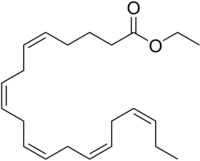
Photo from wikipedia
ABSTRACT Introduction Severe hypertriglyceridemia (sHTG) is a complex disorder of lipid metabolism characterized by plasma levels of triglyceride (TG) greater than 885 mg/dl (>10 mmol/L). The treatment of sHTG syndromes… Click to show full abstract
ABSTRACT Introduction Severe hypertriglyceridemia (sHTG) is a complex disorder of lipid metabolism characterized by plasma levels of triglyceride (TG) greater than 885 mg/dl (>10 mmol/L). The treatment of sHTG syndromes is challenging because conventional treatments are often ineffective in reducing TG under the threshold to prevent acute pancreatitis (AP). The inhibition of APOC3, which encodes a protein involved in triglyceride (TG)-rich lipoproteins (TGRLs) removal, has been reported to be a novel target for the treatment of sHTG. Volanesorsen is a second-generation antisense oligonucleotide inhibiting apoC-III transcription/translation that has been recently approved in Europe for Familial Chylomicronemia Syndrome (FCS) treatment. Areas covered This review summarizes the evidences on the efficacy and safety of volanesorsen for the treatment of sHTG syndromes. Expert opinion Volanesorsen effectively reduces TG in sHTG through a mechanism that is mainly LPL-independent, potentially decreasing the risk of AP. Some safety concerns have been raised with the use of volanesorsen, mainly represented by the occurrence of thrombocytopenia. Due to the potential severity of side effects, some caution is needed before affirming the long-term utility of this drug. Despite this, volanesorsen currently remains the only drug that has been demonstrated effective in FCS, which otherwise remains an untreatable disease.
Journal Title: Expert Opinion on Pharmacotherapy
Year Published: 2020
Link to full text (if available)
Share on Social Media: Sign Up to like & get
recommendations!